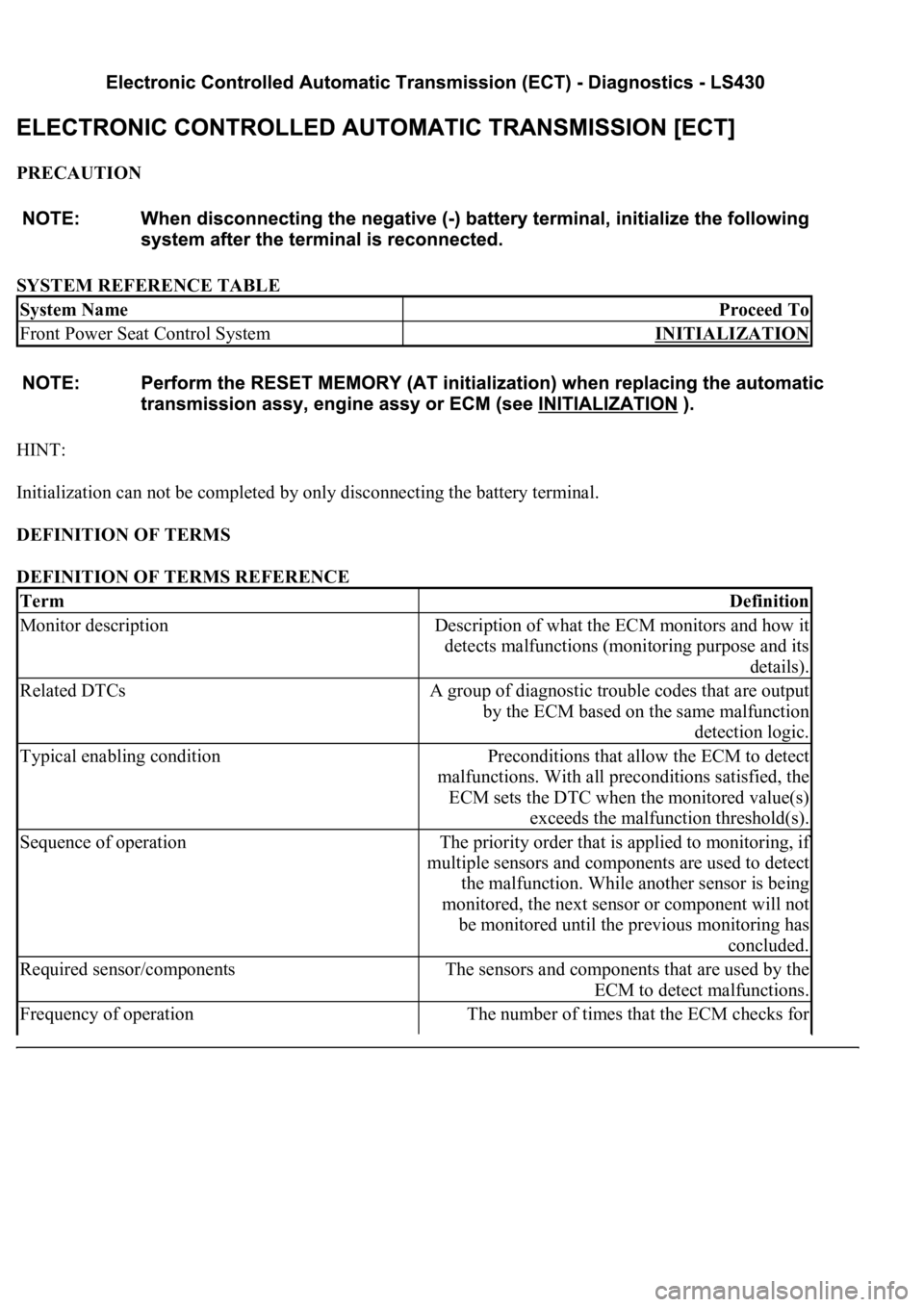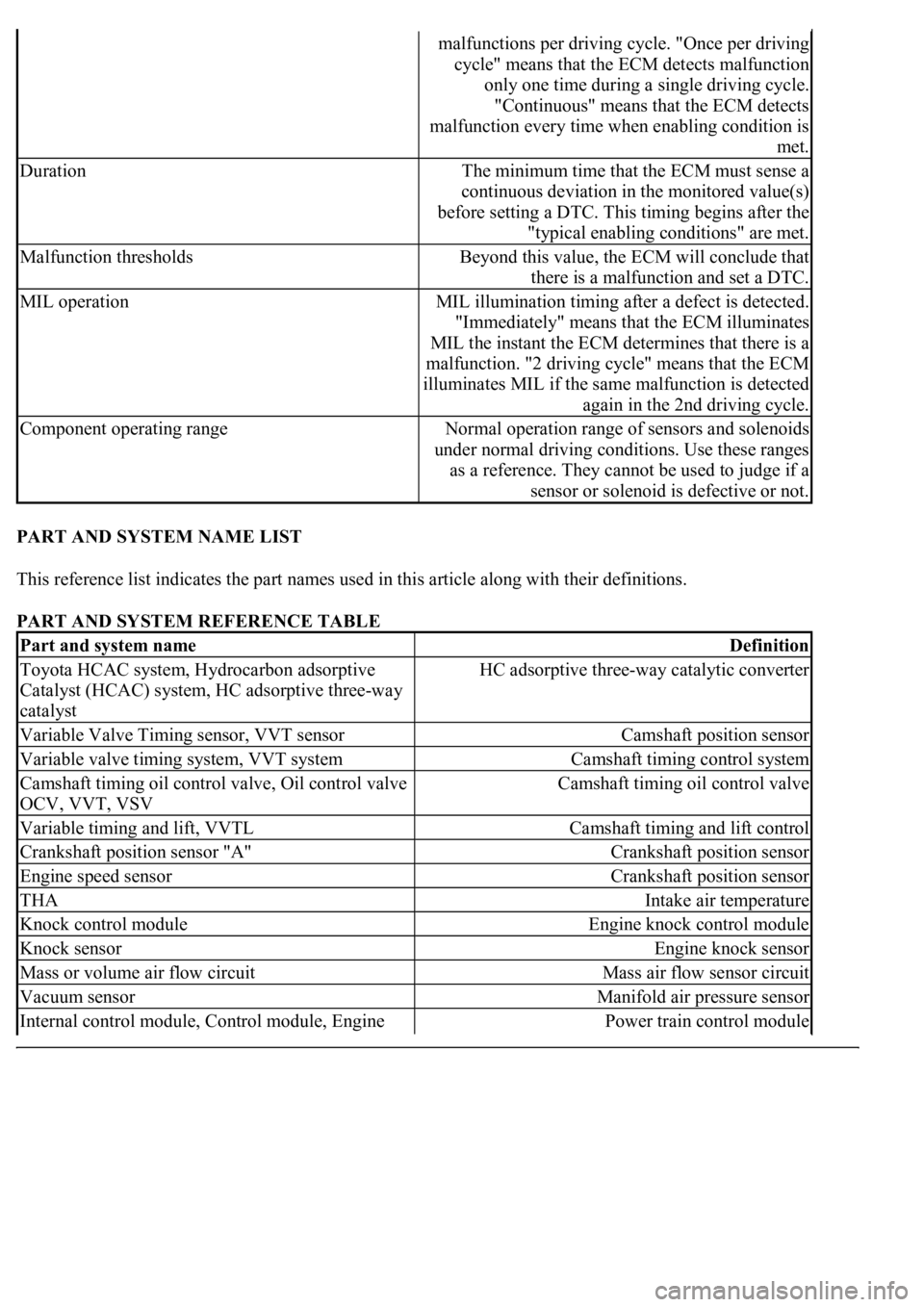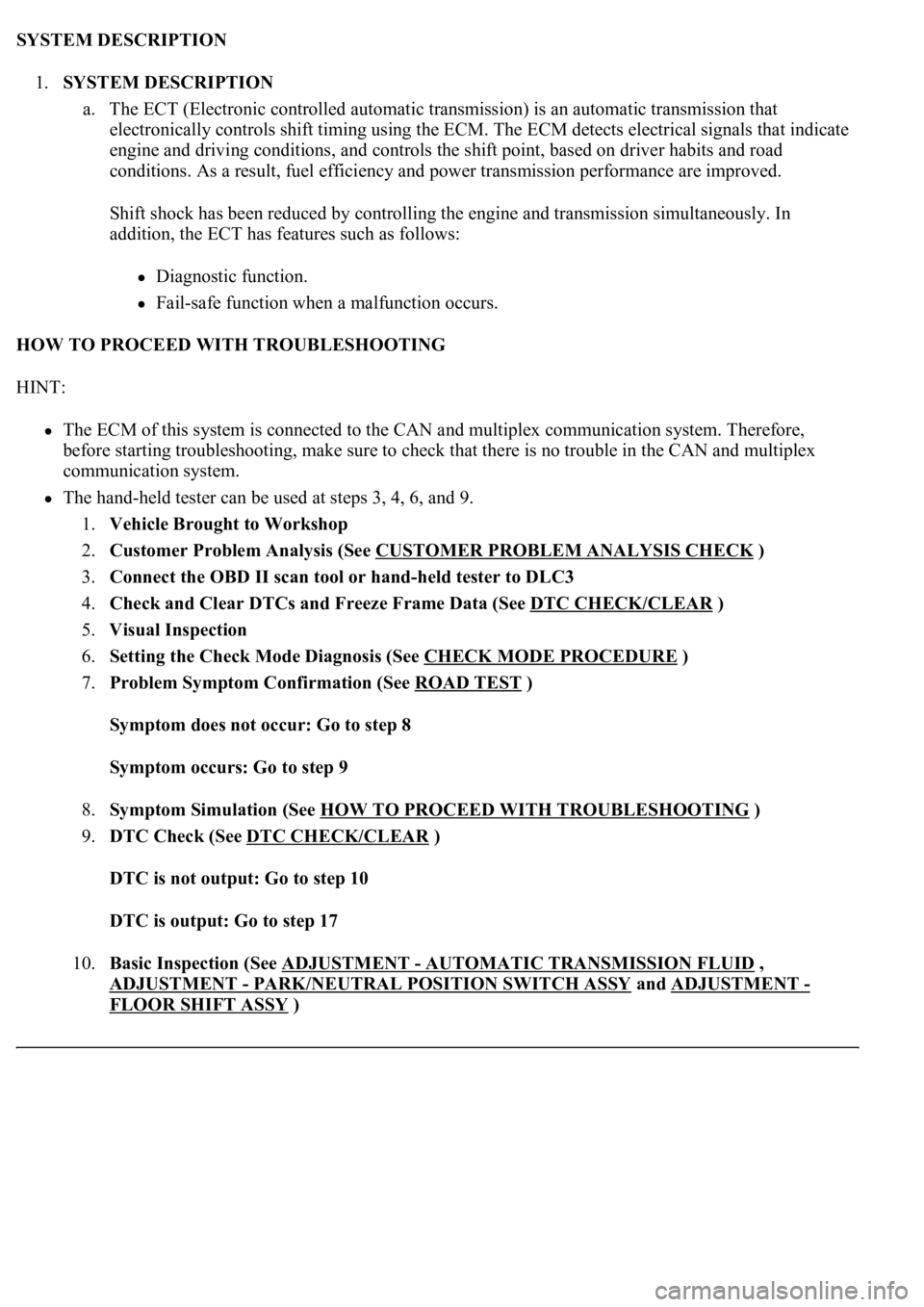Page 2668 of 4500

PRECAUTION
SYSTEM REFERENCE TABLE
HINT:
Initialization can not be completed by only disconnecting the battery terminal.
DEFINITION OF TERMS
DEFINITION OF TERMS REFERENCE
System NameProceed To
Front Power Seat Control SystemINITIALIZATION
TermDefinition
Monitor descriptionDescription of what the ECM monitors and how it
detects malfunctions (monitoring purpose and its
details).
Related DTCsA group of diagnostic trouble codes that are output
by the ECM based on the same malfunction
detection logic.
Typical enabling conditionPreconditions that allow the ECM to detect
malfunctions. With all preconditions satisfied, the
ECM sets the DTC when the monitored value(s)
exceeds the malfunction threshold(s).
Sequence of operationThe priority order that is applied to monitoring, if
multiple sensors and components are used to detect
the malfunction. While another sensor is being
monitored, the next sensor or component will not
be monitored until the previous monitoring has
concluded.
Required sensor/componentsThe sensors and components that are used by the
ECM to detect malfunctions.
Frequency of operationThe number of times that the ECM checks for
Page 2669 of 4500

PART AND SYSTEM NAME LIST
This reference list indicates the part names used in this article along with their definitions.
PART AND SYSTEM REFERENCE TABLE
malfunctions per driving cycle. "Once per driving
cycle" means that the ECM detects malfunction
only one time during a single driving cycle.
"Continuous" means that the ECM detects
malfunction every time when enabling condition is
met.
DurationThe minimum time that the ECM must sense a
continuous deviation in the monitored value(s)
before setting a DTC. This timing begins after the
"typical enabling conditions" are met.
Malfunction thresholdsBeyond this value, the ECM will conclude that
there is a malfunction and set a DTC.
MIL operationMIL illumination timing after a defect is detected.
"Immediately" means that the ECM illuminates
MIL the instant the ECM determines that there is a
malfunction. "2 driving cycle" means that the ECM
illuminates MIL if the same malfunction is detected
again in the 2nd driving cycle.
Component operating rangeNormal operation range of sensors and solenoids
under normal driving conditions. Use these ranges
as a reference. They cannot be used to judge if a
sensor or solenoid is defective or not.
Part and system nameDefinition
Toyota HCAC system, Hydrocarbon adsorptive
Catalyst (HCAC) system, HC adsorptive three-way
catalystHC adsorptive three-way catalytic converter
Variable Valve Timing sensor, VVT sensorCamshaft position sensor
Variable valve timing system, VVT systemCamshaft timing control system
Camshaft timing oil control valve, Oil control valve
OCV, VVT, VSVCamshaft timing oil control valve
Variable timing and lift, VVTLCamshaft timing and lift control
Crankshaft position sensor "A"Crankshaft position sensor
Engine speed sensorCrankshaft position sensor
THAIntake air temperature
Knock control moduleEngine knock control module
Knock sensorEngine knock sensor
Mass or volume air flow circuitMass air flow sensor circuit
Vacuum sensorManifold air pressure sensor
Internal control module, Control module, Engine Power train control module
Page 2676 of 4500

SYSTEM DESCRIPTION
1.SYSTEM DESCRIPTION
a. The ECT (Electronic controlled automatic transmission) is an automatic transmission that
electronically controls shift timing using the ECM. The ECM detects electrical signals that indicate
engine and driving conditions, and controls the shift point, based on driver habits and road
conditions. As a result, fuel efficiency and power transmission performance are improved.
<0036004b004c0049005700030056004b00520046004e0003004b00440056000300450048004800510003005500480047005800460048004700030045005c0003004600520051005700550052004f004f004c0051004a00030057004b004800030048005100
4a004c00510048000300440051004700030057005500440051[smission simultaneously. In
addition, the ECT has features such as follows:
Diagnostic function.
Fail-safe function when a malfunction occurs.
HOW TO PROCEED WITH TROUBLESHOOTING
HINT:
The ECM of this system is connected to the CAN and multiplex communication system. Therefore,
before starting troubleshooting, make sure to check that there is no trouble in the CAN and multiplex
communication system.
<0037004b00480003004b0044005100470010004b0048004f0047000300570048005600570048005500030046004400510003004500480003005800560048004700030044005700030056005700480053005600030016000f00030017000f00030019000f00
030044005100470003001c00110003[
1.Vehicle Brought to Workshop
2.Customer Problem Analysis (See CUSTOMER PROBLEM ANALYSIS CHECK
)
3.Connect the OBD II scan tool or hand-held tester to DLC3
4.Check and Clear DTCs and Freeze Frame Data (See DTC CHECK/CLEAR
)
5.Visual Inspection
6.Setting the Check Mode Diagnosis (See CHECK MODE PROCEDURE
)
7.Problem Symptom Confirmation (See ROAD TEST
)
Symptom does not occur: Go to step 8
Symptom occurs: Go to step 9
8.Symptom Simulation (See HOW TO PROCEED WITH TROUBLESHOOTING
)
9.DTC Check (See DTC CHECK/CLEAR
)
DTC is not output: Go to step 10
DTC is output: Go to step 17
10.Basic Inspection (See ADJUSTMENT
- AUTOMATIC TRANSMISSION FLUID ,
ADJUSTMENT
- PARK/NEUTRAL POSITION SWITCH ASSY and ADJUSTMENT -
FLOOR SHIFT ASSY
)
Page 2687 of 4500
HINT:
The ECM memorizes the condition that the ECT controls the automatic transmission assy and engine assy
according to those characteristics. Therefore, when the automatic transmission assy, engine assy, or ECM
has been replaced, it is necessary to reset the memory so that the ECM can memorize the new
information. Reset procedure is as follows.
a. Turn the ignition switch off.
b. Connect the hand-held tester together with the CAN VIM (controller area network vehicle interface
module) to the DLC3.
c. Turn the ignition switch to the ON position and push the hand-held tester main switch on.
d. Select the item "DIAGNOSIS/ENHANCED OBD II".
e. Perform the reset memory procedure from the ENGINE menu.
HINT:
The ECM is learned b
y performing the ROAD TEST.
Page 2688 of 4500
Fig. 12: Identifying Road Test Flow Chart
Courtesy of TOYOTA MOTOR SALES, U.S.A., INC.
LIST OF DISABLE A MONITOR
HINT:
This table indicates ECM monitoring status for the items in the upper columns if the DTCs in each line on the
left are being set.
As for the "X" mark, when the DTC on the left is stored, detection of the DTC in the upper column is not
performed.
Page 2697 of 4500
<002c004900030057004b0048000300570055005200580045004f0048000300560057004c004f004f00030052004600460058005500560003004800590048005100030057004b00520058004a004b00030057004b0048005500480003004400550048000300
51005200030044004500510052005500500044004f004c0057[ies in any of the other circuits, check
and replace the ECM.
HINT:
*1: When the circuit on which mark *1 is attached is a malfunction, DTC could be output (see
DIAGNOSTIC TROUBLE CODE CHART
).
Fig. 20: Chapter 1 Problem Symptoms Table (1 Of 2)
Courtesy of TOYOTA MOTOR SALES, U.S.A., INC.
Page 2702 of 4500
TERMINALS OF ECM
1.ECM
Fig. 24: Identifying ECM Connector Terminals
Courtesy of TOYOTA MOTOR SALES, U.S.A., INC.
HINT:
Each ECM terminal's standard voltage is shown in the table below.
In the table, first follow the information under "Condition". Look under "Symbols (Terminal No.)" for the
terminals to inspected. The standard voltage between the terminals is shown under "Specific Condition".
Use the illustration above as a reference for the ECM terminals.
Page 2704 of 4500
Fig. 25: Identifying ECM Terminals Reference Chart
Courtesy of TOYOTA MOTOR SALES, U.S.A., INC.
Waveform 1
Fig. 26: Identifying Waveform 1
Courtesy of TOYOTA MOTOR SALES, U.S.A., INC.
Reference:
WAVEFORM 1 REFERENCE TABLE
Waveform 2
TerminalSLT+ - SLT-
Tool setting5V/DIV, 1ms/DIV
Vehicle conditionEngine idle speed